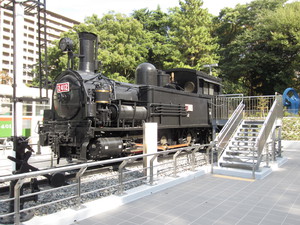Nagoya City Science Museum
TOP > Exhibition Guide > Keyword Search > Starting with "I" > Ishihara Sangyo Kaisya, Ltd. > B6 Steam Locomotive
B6 Steam Locomotive



Purpose of Exhibition
In the yard outside of the Nagoya City Science Museum, steam locomotives which are deeply connected with Nagoya City are on display. We would like you to deepen your understanding of transportation, railroad, and steam engine.
Currently, the B6 steam locomotive is not on display because it has been taken out of the museum for research.
In 2022 a plan has been developed for a new B6 steam locomotive exhibition with the driving-wheels moving.
We are now working on the plan with the goal of exhibiting the locomotive in the outdoor exhibition of our museum in the fall of 2025.
Basic Plan for the Exhibition of the Nagoya City Science Museum's B6 Steam Locomotive and Old Passenger Carriages can been seen here(we are sorry for it's only in Japanese).
Additional Knowledge
[What is the B6 Steam Locomotive?]
B6 was a designation used by the Railroad Work Bureau (an ancestor of the present JR), when it established a locomotive model type designation system in 1898. The D51 is well-known. The B6 steam locomotive was constructed based on a grand design developed in the U.K. Depending on manufacturing years and manufacturers, it has four variations called 2100, 2120, 2400 and 2500 models. This particular specimen exhibited here is numbered 2412, which was manufactured by the Hanover Corporation of Germany in 1904 and imported to Japan for the transportation of military supplies to fulfill logistical needs in the Russo-Japanese war. This steam locomotive became a part of the fleet operated by the Railroad Work Bureau in April 1905 and was used on the Chuo line in the Taisho era and on the Taketoyo line and Takayama line in the Showa era. It was discontinued in January 1948 in the Takayama Locomotive station and then sold to the Yokkaichi Factory of Ishihara Sangyo Kaisha, where it was used on the private line developed on the factory premises until July 1968 for the transportation of cargos and commuting employees.
Therefore, it can be said that the B6 is one of the steam locomotives, which has a deep connection with Nagoya City and the Chubu Area (Midland Area).
[What are Steam Engines and Steam Locomotives?]
In the early 18th century, the iron-manufacturing method using coke was established, and coal excavation, a source of coke, went active. However, as the excavation progressed, spring water became a setback. Steam engines were invented as machinery to get rid of the spring water. A Newcomer's steam engine was in use at first. However, since his engine had bad heat efficiency, in which they had to cool down the entire cylinder, Watt's new steam engine, which split the cooler off the cylinder and was more energy-efficient, was invented.
Watt continued to actuate it with air pressure, because he considered that steam engines using high pressure were dangerous. It was Trevithick that reconstructed it into transportation machinery using high steam pressure and equipped it on rails in 1804. Subsequently, George Stephenson created the locomotive which ran between Stockton and Darlington in Britain as a commercial railway for the first time in the world in 1825.
[First Railway in Japan]
In 1872, although our first railway was constructed between Shinbashi and Yokohama, it was Britain that brought over its technology and invented railways for the first time in the world. Currently, the very first steam locomotive imported into Japan is on display in the railway museum in Saitama city.
Cooperation Ishihara Sangyo Kaisya, Ltd.
B6 steam locomotive movie, privately-owned, at YouTube
Article by Kouichi Mabuchi, Curator
